February 18, 2011
Air Date: February 18, 2011
FULL SHOW
SEGMENTS
The Budget
View the page for this story
President Obama’s budget reduces funding for most federal agencies but the Department of Energy is looking at a 12 percent increase. Energy Secretary Steven Chu tells host Bruce Gellerman that his agency will prioritize financing for clean energy development, including new nuclear facilities. (09:00)
White House Wants to Cut Energy Help for Poor
/ Mitra TajView the page for this story
A federal energy assistance program that began in the Reagan administration could be cut in half by the Obama administration. The president has proposed a $2.5 billion dollar reduction to the budget of LIHEAP, or Low-Income Home Energy Assistance Program, which helps struggling families pay the bills that heat and cool their homes. LOE’s Washington correspondent Mitra Taj reports on the controversial budget item. (05:00)
Toxic Tide - Discovering the Health Effects of the Deepwater Disaster, Part 2
/ Jeff YoungView the page for this story
Sick residents have questions and scientists are looking for answers: might the BP spill be behind a wave of illness? We hear how cleanup workers and coastal communities might have been exposed in part two of Jeff Young’s report Toxic Tide - Discovering the Health Effects of the Deepwater Disaster. (08:30)
Costs of Coal
View the page for this story
Extraction, processing, transportation and combustion of coal create large tolls on the environment and human health. We hear from poet and farmer Wendell Berry who slept in the Kentucky governor’s office to protest mountaintop removal. Host Bruce Gellerman also talks with Dr. Paul Epstein from Harvard University’s Medical School about his new study measuring the true costs of coal. (09:30)
BirdNote ® Sooty Shearwater Migration
/ Michael SteinView the page for this story
The Sooty Shearwater is a seabird that travels enormous distances each year, equal to one and half times around the Earth. BirdNote®’s Michael Stein profiles these frequent fliers. (02:00)
How Close are we to the Edge
View the page for this story
As food prices rise, and civil unrest builds throughout the Middle East, Lester Brown, president of the Earth Policy Institute, wonders if these two could be connected. LOE’s Steve Curwood talks with Brown about how depleting our natural resources could ultimately lead to our demise. (10:00)
Black History Month and Environmental Justice
/ Ebony PayneView the page for this story
Hazel Johnson passed away in January. She leaves a legacy of environmental activism. Johnson fought to clean up asbestos and pollution in her Chicago neighborhood, and worked with the federal government to focus attention on environmental issues affecting minority and low-income communities. Planet Harmony and Living on Earth’s Ebony Payne has this tribute. (03:00)
This week's EarthEar selection
listen /
download
Splish, splash – listen to a herring gull taking a bath.
Show Credits and Funders
Show Transcript
HOST: Bruce Gellerman
GUESTS: Steven Chu, Ira Leifer, Wendell Berry, Paul Epstein, Lester Brown, Marco Kaltofen
REPORTERS: Mitra Taj, Jeff Young, Michael Stein, Steve Curwood, Ebony Payne, Mark Seth Lender
[THEME]
GELLERMAN: From Public Radio International - this is Living on Earth. I’m Bruce Gellerman. For the Secretary of Energy - the bottom line of the President's budget is a choice between two visions of the future. Subsidies for fossil fuels or renewable power…
CHU: You have to ask yourself in 2011 do companies who are making tens of billions of dollars of profit each year really need those subsidies. Then you look at what are the new things coming on the block.
GELLERMAN: Coming up: a conversation with Energy Secretary Steven Chu. Also - our series "Toxic Tide" continues with the mystery of the BP oil dispersants. Exactly where were they used - and when?
KALTOFEN: I’ve wracked my brain trying to think of a reason why I’m finding dispersant inshore, weeks after spraying supposedly stopped. We need to get a better explanation.
GELLERMAN: Those stories and a tribute to a champion of environmental justice just ahead on Living on Earth – stick around!
[THEME]
ANNOUNCER: Support for Living on Earth comes from the National Science Foundation and Stonyfield Farm.
The Budget

Steven Chu is the Secretary of the Department of Energy. (Los Alamos National Laboratory)
GELLERMAN: From the Jennifer and Ted Stanley Studios in Somerville, Massachusetts, this is Living on Earth. I’m Bruce Gellerman. Congress and the White House are still struggling over the budget for the rest of this year – trying to figure out how to tackle the deficit - and pay to keep the government running. But as required by law, the President has unveiled his budget for next year - and it essentially freezes spending.
Well, the President proposes - and Congress disposes - and Congressman Paul Ryan, chair of the House budget committee, is not disposed to approve of the President's proposal.
RYAN: This is not a moderate budget. This is not a triangulation budget. This is a budget that went to the left. It would be better doing nothing than if we would actually pass this budget. For the sake of our economy, for the sake of our future, and for the sake of jobs.
GELLERMAN: But President Obama says creating jobs and the economy of the future are precisely his priorities - though for agencies and departments that regulate the environment, there are pains and gains. The President wants to cut 13 percent from the Environmental Protection Agency’s 10 billion dollar budget. Hardest hit are clean water programs. EPA administrator Lisa Jackson:
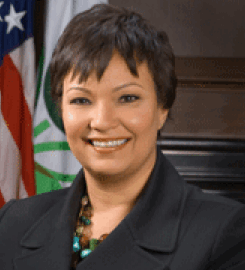
Environmental Protection Agency Administrator, Lisa Jackson. (EPA)
JACKSON: There's no moving away from a greener more sustainable economy. And that commitment remains. It's a tough year, but I think this budget continues an incredible legacy of support from President Obama for this agency.
GELLERMAN: Over at the Department of Agriculture, the President proposes cutting more than 3 billion dollars - much of it by eliminating subsidies to wealthy farmers. One of the few budgets the President wants to increase is the Dept of Energy - boosting it by about 12 percent. Dr. Steven Chu is the Secretary of Energy.
CHU: There was a lot of hard decision made on the overall budget. And the budget proposed for 2012 was a budget which actually put a freeze on the overall spending. There was a determination made, and I think it’s the right call, that in times of austerity, that the last thing you want to do is stop the things that will lead to future prosperity.
It’s the old expression - it’s as if you’re designing an airplane that looks like it’s overweight and the way to trim the weight is to take off an engine.
GELLERMAN: You have big boosts for things like electric vehicles, you have, what, 80 percent increase to nearly 600 million dollars for R&D for advanced vehicles.
CHU: That’s a good example of how to compete to win the future. All around the world, countries and companies take note that we expect great advances and better technologies and system technologies for plug-in and hybrids and electric vehicles. You start with a 100-mile range, but soon graduate to 200, 300, 400-mile range on a single charge.
The companies and the countries that develop that technology will have a world market. We do not want to be importing these cars. We want to be building them in America and exporting them to the entire world.

Steven Chu is the Secretary of the Department of Energy. (Los Alamos National Laboratory)
GELLERMAN: But it’s companies that will make a profit. Why don’t they pay for it?
CHU: What we’re proposing is to do research and development - not today’s batteries that are going into the Chevy Volt, that’s something that should be done by the sector and it has been taken up quite nicely. But we’re proposing a new generation of batteries, which is very basic research and development that could help. Again, other countries are aiding their companies in getting the lead in this technology.
GELLERMAN: In terms of conventional fuels though, subsidies through the Department of Energy for fossil fuels are getting sliced by 44 percent. They’ll still be nearly half a billion dollars, but that’s a big chunk out of fossil fuel subsidies.
CHU: That is somewhat of a legacy, and you have to ask yourself, in 2011, do companies who are making tens of billions of dollars of profit each year really need those subsidies? Then you look at what are the new things coming on the block: photovoltaic advances that could really dramatically lower the price.
Again, it’s going to be a race, among countries and companies to see who can drive those prices down, and make them much more efficient where the target is that they can compete for energy generation with fossil fuels without subsidy.
GELLERMAN: I wanted to ask you about the federal loan guarantees to nuclear power plants - the construction of new nuclear power plants. In your proposed budget for 2012, you’re asking for seed money to basically start 36 billion dollars in loan guarantees.
CHU: That’s correct. We want to restart the nuclear industry. We think that nuclear power in this century will be an essential part of the mix of power generation. It’s clean power generation. And, quite frankly, we want to restart our nuclear industry to get back in the game.
China – worldwide now, ground has been broken on about 50 nuclear reactors, of which China is building half of them. There’s an anticipation worldwide to have a nuclear renaissance. That you can build these nuclear reactors that will be far safer than the earlier ones, and it’s also about energy security and clean energy.
GELLERMAN: I believe there’s a line-item in the President’s FY 2012 budget for something I find kind of curious - modular nuclear power plants.

The Department of Energy is investing in modular nuclear reactors like this. (The Nuclear Former)
CHU: Yes. These are called small modular power plants - at the scale of let's say, 100 megawatts instead of 1,000 or 1,500 megawatts. And that can be done and built in a factory in a single location, and not only shipped around the United States, it could be shipped around the world. And again, this is where we can regain leadership in the nuclear industry.
And so, the Department of Energy is very enthusiastic about trying to support the research and development, and also the engineering work that could lead to licensing. And so, this idea of continuing this innovation chain, starting from basic discoveries to inventions to ideas for things that go onto the private sector is something the President and I feel very strongly about.
GELLERMAN: Dr. Steven Chu is the Secretary of the Department of Energy. Secretary Chu, thank you very much, really appreciate it.
CHU: Alright. Thank you!
Related links:
- Click here to hear a longer interview with Steven Chu
- Dan Reicher from the Stanford Center on Energy Policy and Finance talks about the DOE budget.
- Highlights from the 2012 budget
White House Wants to Cut Energy Help for Poor
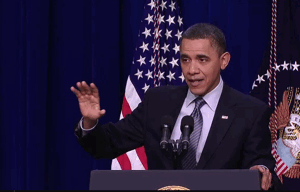
President Barack Obama defends his 2012 budget proposal, including controversial cuts to a federal program that helps the poor pay their energy bills.
GELLERMAN: Secretary Steven Chu is big on energy efficiency. The Department of Energy has been funneling funds into a program to help poor households weatherize their homes - creating jobs, lowering electricity bills, and cutting greenhouse gas emissions. But what could get cut next year is a federal program that helps low income households pay for their energy bills. That's another proposal in President Obama's 2012 budget. Living on Earth's Mitra Taj has our story.
TAJ: Leroy Canty says he knows how the President feels: planning a budget during tough times is a struggle. He’s 64 and retired, but works part-time at a grocery store called Giant Food in Washington.
[GROCERY CARTS CRASHING]
TAJ: He’s a courtesy driver - giving shoppers a ride home in his brown minivan.
[DOOR CLOSES, ENGINE STARTS, BEEPING]
TAJ: His social security check brings him just $900 a month.
CANTY: That’s not a lot of money, not a lot. If it wasn’t for my wife, you know, I’d be up the river without a paddle.
TAJ: As he drives through the city on a cold night, he points toward the convention center - an elegant structure he helped build during the decades he worked as a carpenter. Now, it’s where he goes to apply for help to pay his heating bills. He says in his neighborhood, he’s not the only one who gets in line for federal funding.
CANTY: Most everybody around here uses it. The two tall buildings right here, all these people around here…everybody uses it. So if they’re gonna cut it - oh my goodness that’s gonna be a thing.
TAJ: LIHEAP, or the Low-Income Home Energy Assistance Program, started under the Reagan administration. Now the Obama administration proposes cutting it in half from its current $5.1 billion dollars. If Congress approves the president’s proposal, Canty and his wife will have to pay $140 a month for their winter electricity bills instead of about $20.
But Obama says he’s just restoring LIHEAP’s budget to what it was in 2008, before Congress doubled it to cover a spike in energy prices.
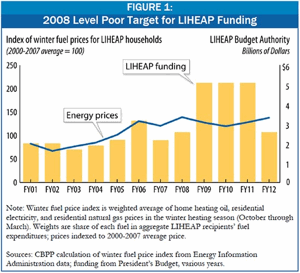
CBPP's analysis shows winter fuel prices on the rise as LIHEAP funding could be cut.
OBAMA: Energy prices have now gone down, but the costs of the program have stayed the same. So what we've said is, "Let's go back to a more sustainable level. If it turns out that once again you see another huge energy spike, then we can revisit it."
TAJ: But Chad Stone, chief economist with the progressive Center on Budget and Policy Priorities, says energy costs are about to go up again.
STONE: The administration’s argument that energy prices are substantially lower than they were in 2008 - that’s true about what prices were in the summer. But it turns out that the prices that matter for LIHEAP for the most part are prices for the winter heating season. And the forecast is that this coming winter, prices are going to be about that same level.
TAJ: A lot depends on how you heat your home. While natural gas prices have gone down, heating oil and propane prices have gone up. Mark Wolfe is the executive director of the National Energy Assistance Director’s Association. He says, in 2008, the annual average cost to heat a home was 1,010 dollars. Now it’s 960 dollars.
WOLFE: So for those families, when you say prices have come down, they don’t know what you’re talking about. As far as they’re concerned, it’s as high as ever.
TAJ: No one in Congress has come out to enthusiastically embrace Obama’s LIHEAP budget cut for 2012. And Nick Loris, with the conservative Heritage Foundation, says he can understand why.
LORIS: When we’re spending, you know, billions of dollars a year and we’ve run a 14 trillion dollar deficit, a two billion dollar cut or five billion dollar program targeted towards low income energy assistance isn’t the most politically attractive one to remove.
TAJ: Like many Republicans, Loris thinks increasing domestic energy production is the answer to lowering energy prices for people in need.
Some suspect the President is trying to look tough on the deficit, while betting lawmakers will save the popular program. But if the cuts do go through, Mark Wolfe says three million people will be pushed off the program and toward risky decisions.
WOLFE: We know what they do – there’s plenty of research now. They turn the heat down to sometimes dangerously low levels. If you're an elderly person and your house is cold, your high blood pressure medicine doesn't work as well, we know that there are higher rates of stroke and other illnesses.
TAJ: Leroy Canty says he’d do what he did before he knew about LIHEAP - he’d turn off his heater, and turn on the stove, even though he knows he risks carbon monoxide poisoning.
CANTY: It is very dangerous, that's why you put it on for a little while, you know, like 2-3 hours, then you go and cut it back out, then wake up in about another 2-3 hours, go back, put it back on, but that’s still dangerous you know. But a lot of people just use theirs the whole night and that's not good.
TAJ: The ball is now in Congress’s court, and House Majority speaker John Boehner has said painful cuts, including those to LIHEAP, are needed because “we’re broke.” For Living on Earth, I’m Mitra Taj in Washington.
GELLERMAN: Well, balancing the budget is difficult, but it’s no easy task lifting it either. President Obama’s proposal makes for heavy reading. It’s two thousand four hundred and forty-eight pages, weighing in at a whopping 10 pounds. Thirty thousand copies are printed which adds up to nine million, two hundred and sixty-one thousand, one hundred and eight sheets of paper - or 1100 trees.
But the paper contains 30 percent recycled material, and the ink is vegetable oil based. If you want your own copy of all four volumes it will set you back a budget-busting two hundred and fourteen bucks. But shipping is free - and there is no tax.
Related links:
- Click here for Chad Stone's analysis of energy prices and LIHEAP funding.
- Recent stats on growing demand for LIHEAP.
- Why Nicolas Loris supports cutting LIHEAP's budget.
- NEADA looks at how many people could be cut out of assistance.
[MUSIC: Bill Frisell/Vinicius Cantuaria “Calle” from Lagrimas Mexicanas (Nonesuch Records 2010).]
GELLERMAN: Just ahead - a sleep-in to protest mountaintop mining and calculating the real cost of coal. Keep listening to Living on Earth!
[CUT-AWAY MUSIC: Brian Auger: “Happy Overture” from Looking In The Eye Of The World (Yellow Label 2007).]
Toxic Tide - Discovering the Health Effects of the Deepwater Disaster, Part 2
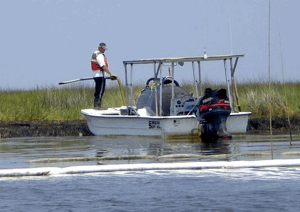
Fishermen turned their boats into an oil spill armada. Now many worry about what they were exposed to on the water. (Photo: Marco Kaltofen)
GELLERMAN: It’s Living on Earth, I’m Bruce Gellerman. From a scientific perspective the BP oil disaster was a giant, unintended, experiment. There had never been an oil disaster of such magnitude, in such deep water, where so much chemical dispersant was used. Now, 10 months later, Gulf coast residents are reporting a wave of strange illnesses that many suspect are related to the spill.
Some who say they have symptoms are workers who cleaned the crude from the sea and beaches. Others live along the coast where oil washed ashore. All are searching for answers – and scientists now have some surprising findings on how they may have been exposed. Here’s Living on Earth’s Jeff Young with the second part of his investigative special: Toxic Tide - Discovering the Health Effects of the Deepwater Disaster.

A NASA image of air above the Deepwater spill in May, 2010, as seen with the remote sensing technology known as Lidar. The red indicates aerosols over the spill. (NASA)
YOUNG: We’ll call him “John” - he does not want to use his real name. From June through November, John worked for a company BP hired to clean up oil in Louisiana’s hard hit Barataria Bay. His boat had a vacuum device to suck up the oil and dispersant mixture. Often, he’d smell it before he saw it.
“JOHN”: You could smell the hydrocarbons in the air and just smell that oil and you knew it was coming in. As the wind blew, some days you’d get really nauseous - our skin would itch a lot, and, it was just tough.
YOUNG: John says he was not offered use of a respirator or other protective gear. Some crewmembers quit out of health concerns. Now he’s wondering about health effects, too.
“JOHN”: There were many times when we felt that, you know, we were getting sick and we probably should have had respirators on. And, to this day, I’m pretty upset because I just was not informed of the contaminants that could affect me and my life as I go down the road.
YOUNG: In one way, John’s story is like many others from spill responders concerned about chemical exposure during their work on the Gulf. But John’s story is different in that his comes with hard data, thanks to a personal air-monitoring device.
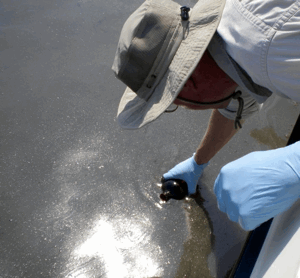
Marco Kaltofen says samples he collected show chemical dispersants closer to shore and much later than they should have been used. (Marco Kaltofen)
KALTOFEN: What I’ve got in this little tube is…
[RATTLING SOUND]
KALTOFEN: This is a small cartridge. It looks like a small brass pen.
YOUNG: Civil engineer Marco Kaltofen shows the device John wore.
KALTOFEN: As they move through the oil and dispersant, these tiny samplers, with no moving parts, are picking up those chemicals. So we can take them back to the laboratory and measure what was in the air they were breathing while they were working.
YOUNG: Kaltofen is a researcher at Worcester Polytechnic Institute in Massachusetts. He’s also head of an environmental research company called Boston Chemical, which was hired by a New Orleans personal injury law firm to collect samples. Kaltofen says samples from monitors clipped to John and other fishermen-turned-cleanup workers showed what are called “BTEX” compounds.

Fishermen turned their boats into an oil spill armada. Now many worry about what they were exposed to on the water. (Marco Kaltofen)
KALTOFEN: BTEX stands for benzene, toluene, ethylbenzene and xylenes. These are some of the lightest, most readily volatile compounds that are out there in that dispersant crude oil mix. And that’s where we found something very interesting, too. It was not the crude oil that was responsible for most of the volatile compounds we’re seeing, but it was actually the dispersant.
YOUNG: Why do you say that?
KALTOFEN: When we took the dispersant and the crude oil into the laboratory to measure how they partition - how they divide up into the different parts in the environment. When we did that, and we looked at the air above our tanks of seawater, we were finding that the same volatile chemicals that were in the air around the fishermen were the ones that we found in the air above the dispersant-seawater mixtures.
YOUNG: Those volatile chemicals likely come from the petroleum distillates mixed with the Corexit brand dispersants. At least 1.8 million gallons of chemical dispersants were used during the spill.
The chemicals most prevalent in the lab tests can affect the cardiovascular and nervous systems, liver, and kidneys. Corexit maker Nalco declined comment, citing litigation. Kaltofen says he had another surprising finding: he found dispersants closer to shore than they should have been used.
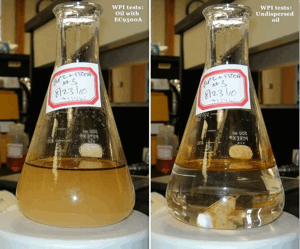
Lab tests show the chemical dispersants emit volatile organic compounds, a potential health concern. (Marco Kaltofen)
KALTOFEN: It’s confusing to us that we can go one mile off of Biloxi and find dispersant in the seawater - enough that it reeks because of the hydrocarbon odors. And when we got those samples into the lab, we found that we had multiple hits for dispersant compounds. So how could they get into the inshore waters and how could they still be there weeks after application supposedly ended? We need to get a better explanation.
YOUNG: The presidentially-appointed oil spill commission looked into the persistent citizen complaints that dispersants were being sprayed too close to shore. A commission staffer says reviews of Coast Guard operation logs found no evidence to support that.
Kaltofen’s work gives us some ideas about how those working on the water might have been exposed to toxics. But what about people who live along the coast? Robin Young of Orange Beach, Alabama, is among the many Gulf Coast residents who say they fell ill not long after oil started coming ashore.
R. YOUNG: We have way too many people that are sick with very odd symptoms that they have never experienced before in their life. So there’s something going on!
YOUNG: The Environmental Protection Agency monitored air quality during the spill and reported few incidents that would raise a health concern. But University of California Santa Barbara oceanographer Ira Leifer is taking a close look at how coastal communities might have been affected.
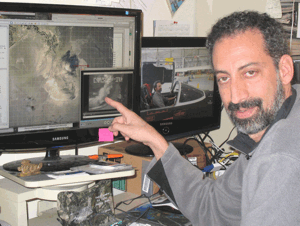
UC-Santa Barbara scientist Ira Leifer coordinated NASA’s remote sensing mission during the BP blowout. (George Foulsham, UCSB Office of Public Affairs)
Leifer was chief mission scientist for NASA’s airborne remote sensing during the spill. Measurements and images from satellites, aircraft, and ships give him a good picture of how components of the oil traveled from the sea and into the air. The same method used to measure the thickness of oil slicks on water, for example, also revealed oil in clouds.
LEIFER: Where there was some of these clouds, they showed up as if they had almost a millimeter of oil in the cloud. And these hydrocarbon-laden clouds - when they reach land - would in fact rain oil.
Leifer thinks this oil rain is an unprecedented oil spill phenomenon - a combination of the Gulf’s high humidity and the columns of thick smoke from burning oil. A lot of things about the BP blowout made it unlike other oil spills.
Most spills happen all at once, say, when a tanker or pipe ruptures. The BP wellhead kept spewing for 87 days, sending oil to the surface in a plume that Leifer says kept pushing the oil’s toxic chemicals into the air.
LEIFER: Air sampling that was conducted both on a boat and by NOAA in the atmosphere showed that this plume contained numerous components and that these components were…many of them are toxic, bearing some similarity to the volatiles you might find in gasoline.
YOUNG: Prevailing winds could have carried those chemicals onshore. Leifer wanted to know what that might mean for public health. The scientific literature on toxicology and oil spills is thin. So he instead used well-known health data from chronic exposure to gasoline and plugged that data into his model.
LEIFER: By that measure, my quick calculation suggested that for an adult healthy persona: maybe an effect, maybe not. For a baby, levels were a thousand to ten thousand times where one starts to see effects.
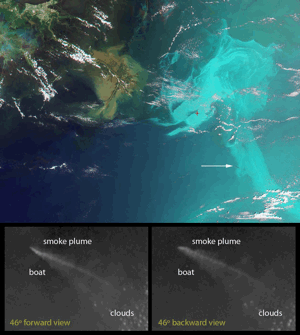
NASA image from summer 2010 shows the oil slick and a plume of smoke from burning oil. Ira Leifer says remote sensing data confirm the phenomenon of “oil rain.” (NASA)
YOUNG: Leifer is quick to add caveats - his results have not yet been tested and his model makes assumptions that might prove wrong. But he thinks it’s important for health researchers to follow through, focusing on the implications for infants, the elderly, and others more susceptible to chemical exposure.
The National Institutes of Health will soon launch a large-scale, long-term health study of cleanup workers. And the NIH just called for proposals to study community health effects of the spill. If the number of anecdotal reports of illness around the Gulf is any indication, there’s no shortage of work to be done. For Living on Earth, I’m Jeff Young.
GELLERMAN: You can hear part one of Jeff’s special report, find out a lot more about what was in the air during the spill, and see some eye-popping NASA images of the BP oil disaster at our website LOE dot ORG.
Related links:
- Jeff Young talks with Riki Ott, scientist and self described “Exxon Valdez survivor” now working with Gulf Coast residents concerned about health effects of the BP spill.
- Hear part one of the report
- EPA’s testing of chemical dispersant toxicity
- The Centers for Disease Control data on oil spill health surveillance
- Corexit maker Nalco’s information on its product
- Boston Chemical Data Corp.
Costs of Coal
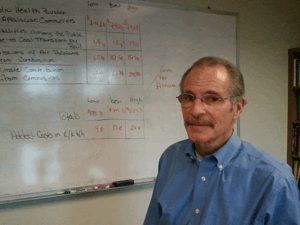
Harvard Medical School’s Dr. Paul Epstein. (Photo: Bruce Gellerman)
Left aligned picture
GELLERMAN: Wendell Berry is a celebrated poet and essayist, a full time farmer in Henry County, Kentucky - and a part-time protestor. On a recent Friday afternoon, Berry and 13 other demonstrators occupied the office of the Governor of Kentucky to protest mountain top removal.
That’s the method mining companies use where they blast the summits off of coal rich mountains, extract the coal, and dump the debris in rivers and valleys below. Wendell Berry says when the demonstrators arrived to occupy the governor's office - they got an unexpected welcome.
BERRY: He invited us to be his guests in his reception room for the weekend. The weekend turned out to be - for all of us - a wonderful experience. It would have been a wonderful experience if we had only each other’s company. But, it turned out, we had several times more food than we could eat. People sent in blankets, pillows, mattresses, toothbrushes, and even equipment to give every one of us a massage.
GELLERMAN: (Laughs).
BERRY: So, it was a weekend of wonderful camaraderie with one another.
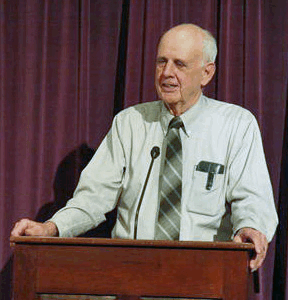
Farmer, Author and activist, Wendell Berry at the Frankfort, Indiana Community Public Library, 4 November 2005. (Wikipedia Creative Commons)
GELLERMAN: So why did you occupy the office of the Governor of Kentucky?
BERRY: Because the issue is very large and very urgent: that is, the destruction of the coalfields of eastern Kentucky, by surface mining at its most violent, which is to say - mountaintop removal.
GELLERMAN: Well, what did you want the Governor to do about it?
BERRY: You have to understand - our complaint is in the context of a virtual dead-silence for many years on the part of state government. We have done everything we could think of to get a hearing - without any effect whatsoever. So this was simply the next thing if we were going to continue our opposition to those mining practices.
GELLERMAN: So you went to the Governor’s office - did you expect to stay for four days?
BERRY: We expected that we would be arrested. Everything that happened was unexpected. We went expecting that the Governor probably would not speak with us, but he did. We went expecting that he would not agree to anything we asked of him, and he did agree to two of our requests.
One, that he would visit the home places of a number of our members and see for himself the problems that they endure everyday. And he agreed to deplore the use of violent language against the people on our side. I think that our weekend was a success to the extent that we did make the issues more public than they’ve been before. We’ve taken a step, and I don’t know how big a step it is, but we’re farther ahead in our efforts than we were last Friday morning.
GELLERMAN: I understand that you took in a copy - a well-worn copy - of Shakespeare’s “The Tempest.” Why?
BERRY: Because it fit very comfortably inside my jacket. And when I am in strange circumstances, such as the Governor’s office, I take a great deal of comfort from reading Shakespeare.
GELLERMAN: Is there a message, a part of the passage that is appropriate for the protest?
BERRY: (Laughs). I hit on a line in my reading of the “Tempest” that I then read to my associates. The line is: ‘misery makes for strange bedfellows.’ (Laughs). We all appreciated the appropriateness of it, but we also appreciated that none of us was miserable.
GELLERMAN: Well, Mr. Berry, I appreciate you talking with us. Thank you very much.
BERRY: Thank you very much.
GELLERMAN: Poet and protester Wendell Berry. He's back on his farm after demonstrating against mountain top removal in Kentucky. Well, mining is just one of the costs of coal, but there are others. There's the cost of transporting, processing, and burning coal - but these aren’t reflected in the price consumers pay.
Dr. Paul Epstein, Associate Director of the Center for Health and Global Environment at Harvard Medical School, has calculated the real cost of coal. And he recently dropped by to do the numbers.
[BELL…. “I’ll get it…”]
EPSTEIN: Is Bruce Gellerman here?
GELLERMAN: Hi, Dr. Epstein, I’m Bruce.
EPSTEIN: Good to meet you!
GELLERMAN: Well, thank you for coming in! I thought since we have so many numbers to talk to you about, we’d go to the Living on Earth conference room, and we’ve got a whiteboard there, and you can write up a storm.
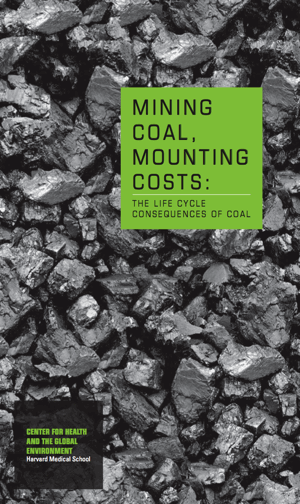
EPSTEIN: We’ll fill it up.
GELLERMAN: (Laughs). Okay, come on.
[DOOR CLOSING]
GELLERMAN: So we invited Dr. Paul Epstein to Living on Earth to discuss his new study about the true costs of coal. Nearly half of the electricity in the United States comes from coal, because it’s the cheapest fuel. But, Dr. Epstein, you say that ain’t so.
EPSTEIN: What we pay for coal makes it seem like it’s cheap, but the cost to taxpayers - to the general public in terms of health and
environmental impacts - are enormous.
GELLERMAN: Economists call those externalities.
EPSTEIN: These are externalities, because it’s external to what we pay the coal companies and the power companies - hidden costs of coal.
GELLERMAN: Well, we put a grid here on the whiteboard, and we left some open spaces. We copied this from your study, and you have a lot of categories, I guess about eight or nine categories of the ‘hidden costs’. Let’s deal with the first one: the public health burden in Appalachian communities. What’s that?
EPSTEIN: Well, this is the impacts of air pollution and water pollution, primarily.
GELLERMAN: So what’s the price tag for that?
EPSTEIN: We’ve added up the deaths - about 75 billion dollars per year.
GELLERMAN: It’s billions!
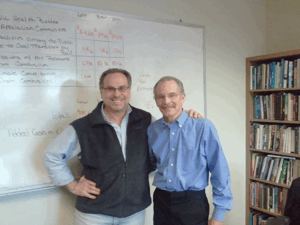
Dr. Paul Epstein and LOE host Bruce Gellerman. (Jessica Ilyse Smith)
EPSTEIN: These are billions of dollars per year…is what we’re finding it costs the population in terms of their deaths.
GELLERMAN: And this is just in Appalachia!
EPSTEIN: This is just in Appalachia. We’re not talking about Wyoming, or Colorado, or other places in the nation that also mine coal - about 75 billion dollars per year.
GELLERMAN: You have fatalities among the public due to coal transportation by railroad.
EPSTEIN: So we looked at the whole life cycle. Mining - meaning mountaintop and underground, transport to the processing plants, transport in railways to the coal combustion plants. Seventy percent of our railway traffic is coal in this nation.
Think of all the wonderful things we could be doing with all those rail cars for getting around and so on. But, just because of that transport, that has a number of fatalities, and that’s what gives us this figure of 1.8 billion in terms of lives lost from accidents due to coal transport by rail.
GELLERMAN: Now, you have emissions of air pollutants from combustion.
EPSTEIN: Now this is the one that gets most attention. This is the noxes and the soxes and the ozone and the particulate matter. Every time we look at particulate matter, we are appreciating that even very low values affect cardiovascular and lung disease. So these are the deaths from air pollution - what you think of when you think of coal.
[EPSTEIN WRITES ON THE WHITEBOARD]
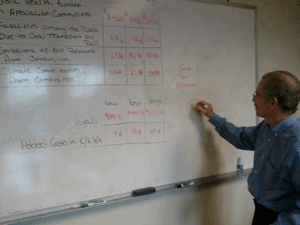
Dr. Epstein does the numbers. (Photo: Bruce Gellerman)
EPSTEIN: 187.5 billion is our best estimate, per year, that’s attributable to air pollution.
GELLERMAN: You write that, as the levels of coal mining increase in Appalachia, so do the poverty rates and unemployment rates in the area. How is that?
EPSTEIN: Yeah, it seems counter-intuitive, but in fact, the dominant form of mining that is increasing now is the mountaintop removal. And this employs very few people, higher-skilled folks that are driving Caterpillars to move earth and dig up the mountain and blast it away… so, in West Virginia, for instance, it’s less than one percent of the population that is employed in coal today.
GELLERMAN: Okay, then we have climate contribution from combustion. This would be…greenhouse gasses?
EPSTEIN: Just mountaintop removal removes trees - it removes soil, and just from that we get carbon. And then methane’s released from some of the mines. This in itself is contributing to climate change - just the mining.

Harvard Medical School’s Dr. Paul Epstein. (Photo: Bruce Gellerman)
When we look at the burning of coal, we’re talking about carbon dioxide, methane, and we’re also looking at black carbon, soot, or particulate matter, which traps heat in the atmosphere. So, looking at the climate contribution of just combustion, we get a range based on what’s called the ‘social cost of carbon’ - what comes out to 205.8 billion dollars a year.
GELLERMAN: Real money! So if we were to take the true value of the cost of electricity, it would be a lot more.
EPSTEIN: So all of that adds up to somewhere between a third and a half a trillion dollars per year that we can attribute are the external costs of coal. We estimate this would double or even quadruple the cost of coal that we would pay in cents per kilowatt-hour. Coal becomes very expensive if we look at these external costs, and it makes wind and solar and smart-grid highly competitive.
GELLERMAN: Well, Dr. Epstein, thank you very much for coming in, I really appreciate it.
EPSTEIN: Thank you, Bruce.
Watch Dr. Epstein explain his figures for the true costs of coal. (Jessica Ilyse Smith)
GELLERMAN: Dr. Paul Epstein is the Associate Director of the Center for Health and the Global Environment at Harvard Medical School, and lead author of the study “Full Cost Accounting for the Lifecycle of Coal.” It’s in the latest edition of the annals of the New York Academy of Sciences.
Related links:
- Harvard Medical School’s Center for Health and the Global Environment
- (PDF) Read the summary of the report.
- Read the Treehugger article, “Activists Occupy Kentucky Governor’s Office Demanding End to Mountaintop Removal Mining”
- Learn about Wendell Berry’s books
[MUSIC: Timewarp Inc “I Feel Lucky (Mellow Edit)” from Dub My Funky Groove (Timewarp Music 2005).]
GELLERMAN: Just ahead - how to Prevent Environmental and Economic Collapse. Stay tuned to Living on Earth!
[CUT-AWAY MUSIC: Brian Auger: “Ghost Town” from Looking In The Eye Of The World (Yellow Label 2007).]
ANNOUNCER: Support for the environmental health desk at Living on Earth comes from the Cedar Tree Foundation. Support also comes from the Richard and Rhoda Goldman Fund for coverage of population and the environment. And, from Gilman Ordway - for coverage of conservation and environmental change. This is Living on Earth on PRI, Public Radio International.
BirdNote ® Sooty Shearwater Migration

Sooty Shearwater flying (© Tom Grey)
GELLERMAN: It’s Living on Earth, I’m Bruce Gellerman.
[BIRD NOTE THEME]
GELLERMAN: When it comes to birds, some travel near, others fly far. In this week’s BirdNote®, Michael Stein profiles some avian aviators who are racking up the frequent flier miles.

Sooty Shearwater flying (© Tom Grey)
STEIN: The annual migrations that many birds make are among nature’s greatest marvels. How stunning that a Ruby-throated Hummingbird – that weighs a mere 1/12 of an ounce – flies non-stop across the Gulf of Mexico, a distance of 500 miles.
[HUMMINGBIRD WING HUM]
STEIN: Or that our backyard Barn Swallows of summer retreat, in winter, as far as southern South America.
[BARN SWALLOW CHATTER]
STEIN: Yet these treks pale in comparison to the yearly migration of Sooty Shearwaters.

Sooty Shearwater massive flock (© Tom Grey)
[SOOTY SHEARWATERS CALLING]
STEIN: The Sooty Shearwater is a crow-sized seabird that glides over the oceans on long, slender wings.
[SOUND OF OCEAN WAVES]
STEIN: Scientists attached tiny electronic tags to Sooty Shearwaters in the Pacific Ocean, then tracked the birds’ annual movements. The shearwaters flew enormous, migratory figure eights from Antarctic waters to the coastal currents off California, Alaska, and Japan – and then returned south. The yearly passage traversed 39,000 miles, a distance equal to traveling more than 1 and half times around the Earth.

Sooty Shearwater on water (© Tom Grey)
[SOUND OF OCEAN WAVES]
STEIN: And when you consider that the shearwaters’ migration comprises 20 to 30 million birds, the Sooty Shearwaters’ journey is not only one of the longest but likely the most spectacular of all migrations.
[SOUND OF OCEAN WAVES; SOOTY SHEARWATERS CALLING]
Related links:
- Bird audio provided by The Macaulay Library of Natural Sounds at the Cornell Lab of Ornithology, Ithaca, New York. Barn Swallow recorded by G.A. Keller. Sooty Shearwater recorded by F.N. Robinson. Ruby-throated Hummingbird wing-beats recorded by Martyn Stewart, NatureSound.org
- BirdNote® - Sooty Shearwater Migration was written by Bob Sundstrom. To see a map of the Sooty Shearwater migration, click here.
GELLERMAN: That’s Michael Stein of BirdNote®. To see photos of the Sooty Shearwater – try saying that three times fast - go to our website L-O-E dot org.
[MUSIC: A Setting Sun “Views From The Real World” from Empty Sound (Moodgadget Records 2008).]
How Close are we to the Edge
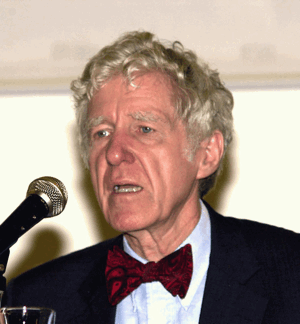
Earth Policy Institute president Lester Brown. (Wikipedia Creative Commons)
GELLERMAN: A recent World Bank study notes that food prices have soared nearly 30 percent just in the past year. Meanwhile, many autocratic regimes in the Middle East that have ruled for decades have suddenly become unstable - as citizens take to the streets, demanding change.
This is not a coincidence says Lester Brown, president of the Earth Policy Institute. He writes that rich nations are adding to the social instability when they buy up land in poor nations to guarantee their own food supply. Lester Brown is a MacArthur Fellow and the author of more than 50 books. His latest is “World on the Edge: How to Prevent Environmental and Economic Collapse.” He spoke with Living On Earth’s Steve Curwood.
CURWOOD: What’s driving the current spike in world food prices? How is this related to rising population, recent crazy weather events? What’s behind all this?
BROWN: On the demand side, we now have three sources of growing demand for grain. One - population growth. The second thing is rising affluence. There are probably close to three billion people in the world today who want to move up the food-chain and consume more grain in terms of livestock products - meat, milk and eggs.
The third thing is - we’re now converting substantial quantities of grain into oil - i.e. ethanol. And what we’re seeing now is that the world’s farmers are having trouble keeping up with the growth and demand. But, on the supply side…climate change. It used to be that if we had a weather event someplace - a monsoon failure in India or drought in the former Soviet Union, or what have you - we knew that if we could get through the next year that things would go back to normal. But there’s no norm to go back to now. The world’s climate is in a constant state of flux.
CURWOOD: You mention climate change. Temperatures are rising around the world. How do crops and other plants react to this?
BROWN: Well, the rule of thumb is that for each one degree Celsius rise in temperature - that’s 1.8 degrees Fahrenheit - we can expect a ten percent decline in grain yields.
CURWOOD: So even the present target that some people talk about - keeping the warming to less than two degrees Centigrade - is going to result in a 20 percent cut in our productivity for food on the planet? In the best case scenario that people talk about…
BROWN: If that comes during the growing season, that’s what we’re looking at.
CURWOOD: What would have happened if we’d had a drought or heat wave like they had in Russia last year?
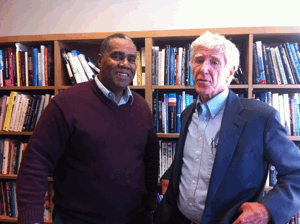
Living on Earth's Steve Curwood with Lester Brown.
BROWN: It’s a useful question with a disturbing answer, because, if the heat wave that was centered in Moscow had instead been centered in Chicago, and we lost 40 percent of our grain harvest as the Russians did, we would have lost 160 million tons, not 40 million tons.
If that had happened, there would now be chaos on world grain markets. Food prices would have been rising throughout the world. Grain-exporting countries would have restricted exports to keep their food prices down, reducing the exportable supplies. Most likely, the oil-exporting countries would have begun to barter oil for grain to make sure they could get the grain they needed.
And much of the rest of the world, including lower income and developing countries, would have been left scrambling for the remaining crumbs. And that would have led to governments falling and food riots on a scale that we’ve not seen before. Because when people get really desperate, they do desperate things.
CURWOOD: How much do you think food and water issues are playing in the present instabilities in Egypt, and other countries in the Middle East?
BROWN: It’s hard to sort out, you know - unemployment and rising food prices and frustrations of having a totalitarian government. But there’s no question that, of all economic indicators, I think the most politically sensitive is food prices. In Egypt, interestingly, we have a country importing over half of the grain it consumes, and producing the other, smaller half, if you will, with imported water via the Nile River.
The difficulty now is - with all the land grabs, land acquisitions by the Chinese, the Koreans, the Saudis and many other countries - in the countries in the Upper Nile River Basin, like the Sudan and Ethiopia, when they acquire that land, they also acquire water in the upper part of the Nile Basin, which means there will be less water for Egypt to produce food with. So, Egypt is faced with growing insecurity in its food supply, both because of the competition for imports, and also because it’s going to be getting less water coming down the Nile.
CURWOOD: In your book, you mention what you call a ‘water-based food bubble’- can you please explain that?
BROWN: Well, as the demand for food has been increasing throughout the world, many countries have expanded irrigation, even though it meant over-pumping their aquifers. And, if it’s a fossil aquifer, it doesn’t recharge. Then once you’ve depleted it, it’s finished. And that’s what’s happened in Saudi Arabia - that’s why their wheat production has collapsed in the last few years and will disappear entirely in the next few years.
CURWOOD: But there are not a lot of people in Saudi Arabia.
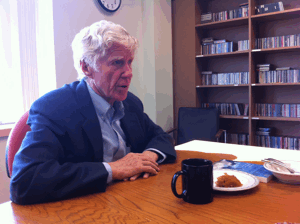
Lester Brown in the Living on Earth conference room.
BROWN: No, but there are a lot of people in India. And in India, most of the aquifers are replenishable aquifers. So if you over-pump there, when you deplete the aquifer, the rate of pumping is necessarily reduced to the rate of recharge. And that’s what countries like India and China are facing.
CURWOOD: What’s the food situation in those two countries, and how might that impact the U.S.?
BROWN: Both countries are vulnerable because of over-pumping. It now looks as though China’s going to be coming into the world market this year for substantial quantities of grain. They will almost certainly come to the United States, because the United States is far-and-away the world’s leading grain exporter. So for American consumers, this is a nightmare scenario - because we are looking at the prospect of 1.4 billion Chinese with rapidly increasing incomes, competing with us for our grain harvest. Driving up our food prices.
Now you can say, ‘Well, if they drive up our food prices too much, we’ll restrict exports.’ But China is our banker. They’re holding 900 billion dollars in U.S. treasury securities. Like it or not, we are going to be sharing our grain harvest with the Chinese, regardless of how much it drives up food prices.
CURWOOD: Care to predict how much more it could cost us?
BROWN: We are somewhat insulated, because if we buy a loaf of bread for two dollars, for example, the cost of the wheat in that bread is maybe ten cents. So the price of wheat doubles, you add another ten percent onto the loaf of bread. But if you live in Northern India or Pakistan, and you buy your wheat in the market, bring it home and then grind it into flour so you can make chapattis - if the price of wheat doubles, you feel it directly. That’s the difference between the developing world and the industrialized world.
CURWOOD: So, if the phone were to ring, Lester Brown, and it’s the White House. They would like to get a briefing on what one might do in the face of the world food situation. What would you tell them? And in particular, how would you define our security?
BROWN: I would first of all say that this current situation, unlike the price surges in the last half of the last century, is not event-driven, it is trend-driven. That doesn’t mean that events like the heat wave in Russia won’t affect it, but it is trend-driven. So, we have to look at those trends and we have to deal with them.
And it includes things like cutting carbon emissions very fast to stabilize climate. It means eradicating poverty and accelerating the shift to smaller families around the world. It means restoring the economy’s natural support systems with forests and soils and aquifers and grasslands and fisheries, and no civilization has ever survived the ongoing destruction of its natural support systems, Mr. President – nor will ours.
What we’re now faced with is a need to re-define security. We have inherited a definition of security from the last century, which was dominated by two World Wars and the Cold War. And so when you mention national security, in the United States, people automatically think military. But, if you were to sit down with a clean slate today, and say, "What are the leading threats to our future?" It is climate change. It is population growth. It is falling water tables. It is rising food prices. It is failing states.
I would say, Mr. President, we not only need to re-define security in a conceptual sense, but also in a fiscal sense. Because what’s needed to eradicate poverty, stabilize population, restore forests and soils and all these things, comes to about two hundred billion dollars of additional expenditures a year. That’s a lot. But - it’s less than a third of the US military budget, and it’s less than a seventh of the global military budget. So, the question is, can civilization as we know it survive these mounting stressors if we don’t get some of the trends generating the stressors turned around.
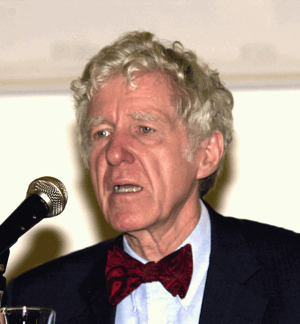
Earth Policy Institute president Lester Brown. (Wikipedia Creative Commons)
CURWOOD: So, what you’re saying, in essence, is: security isn’t a matter of guns so much anymore, as it is butter.
BROWN: Bread.
CURWOOD: Bread and butter.
BROWN: Bread and butter, yeah. That’s the message, Mr. President.
CURWOOD: I know people ask you this - what can they do on an individual level?
BROWN: That’s the question I get more frequently than any other. And I think people expect me to say, you know, ‘Change your lightbulbs and recycle your newspapers…’ And those things are important, but we now have to change the system. I don’t mean a political revolution - I mean we have to restructure the world economy in a way that will dramatically reduce carbon emissions. It’s going to take a lot of political support.
So, it’s becoming politically active. Pick an issue that’s important to you - if it’s creating a world-class recycling program in your community, or helping to close coal-fired power plants, or joining a population group to stabilize world population. This is where our future is going to be determined.
CURWOOD: Lester Brown’s new book is called, “The World on the Edge: How to Prevent Environmental and Economic Collapse.” Thank you so much.
BROWN: Steve, my pleasure. Thank you for focussing attention on these issues.
GELLERMAN: That’s Lester Brown talking with Living on Earth's Steve Curwood.
Related links:
- Click here to listen to an extended interview with Lester Brown.
- Visit the Earth Policy Institute
[MUSIC: Andrew Bird “Natural Disaster” from Noble Beast (Wegawam Music 2009).]
Black History Month and Environmental Justice
GELLERMAN: This February marks the 35th Anniversary of Black History Month in America. It’s a time of celebration and commemoration but this year, it’s also one of sadness - for one of the champions of environmental justice, Hazel Johnson, has died. In this remembrance, Ebony Payne of our sister program Planet Harmony takes us back to February 1994.
PAYNE: Seventeen years ago this month, Hazel M. Johnson stood beside President Bill Clinton and watched nearly two decades of her work signed into law. The Executive Order on Environmental Justice mandated that federal agencies and laws treat minority and low-income communities equitably throughout the states.
Johnson knew firsthand how a toxic environment could tear a community apart. She was born in Louisiana’s infamous ‘Cancer Alley’ - oil refineries sickened her community when she was young. In the 1970s, Johnson lived in Altgeld Gardens, a public housing development in the south side of Chicago. The 190-acre Altgeld was surrounded by about 50 documented landfills, and there were more than 250 chemical waste dumps and storage tanks leaking underground in the area.
Johnson saw cancer-causing asbestos steal the lives of hundreds of her neighbors, including her husband, John. Hazel Johnson was interviewed for the documentary “Altgeld Gardens: Life in a Toxic Environment.”
[JOHNSON IN FILM: Well, I’m used to calling this area a toxic doughnut. We sit in the center of it, and we’re all surrounded by all types of pollution.]
PAYNE: So Johnson took action. She learned that the Riverdale Neighborhood, where Altgeld Gardens sits, had the highest incidence of cancer in all of Chicago, and began to investigate what was killing her community. She founded the People for Community Recovery in 1979. The group educated young Chicagoans about urban environmental issues - and about the toxins that were making them sick.
They pushed city officials to clean up the asbestos, and pressured them to stop the flow of cyanide-contaminated water into a senior citizen’s home. In 1993, Johnson served on the EPA’s first national Environmental Justice Advisory Council. Here, her voice became national, and she helped advise the EPA on how to address environmental justice for the very first time in the history of America. The 1994 Executive Order on Environmental Justice grew from Johnson’s contribution on the EPA council, but went largely ignored during the Bush administration.
Now, Lisa Jackson, EPA’s first black administrator, has put environmental justice high on her agenda. Hazel M. Johnson was called the mother of environmental justice. Her voice may now be silent, but her influence lives on. For Planet Harmony and Living On Earth, I'm Ebony Payne.
GELLERMAN: Our online sister program, Planet Harmony, welcomes all and pays special attention to stories affecting communities of color. Log on and join the discussion at my planet harmony dot com.
[MUSIC:OMAR SOSA “WALKING TOGETHER” FROM CALMA (OTA RECORDS 2011).]
[SFX: HERRING GULL BATHING RECORDED BY MARK SETH LENDER, SALT MARSH DIARY ©]
[OCEAN WAVES AND SPLASHING SOUNDS]
GELLERMAN: We leave you this week on a seawall on Long Island Sound.
[SPLASHING SOUND]
|
|
GELLERMAN: Splish, splash, it's time for a bath. Producer Mark Seth Lender watched as this Herring Gull ducked, tossed water onto its back, then worked its wings and tail like a hand pump, forcing the water through his feathers. To see a slide show of Mark’s photos of herring gulls bathing, go to our website L-O-E dot org.
[CRIES OF HERRING GULLS]
GELLERMAN: Living on Earth is produced by the World Media Foundation. Our crew includes Bobby Bascomb, Eileen Bolinsky, Ingrid Lobet, Helen Palmer, Jessica Ilyse Smith, Ike Sriskandarajah, Mitra Taj, and Jeff Young, with help from Sarah Calkins, and Sammy Sousa. Our interns are Sean Faulk and Wynn Tucker. We had engineering help this week from Dana Chisholm. Jeff Turton is our technical director. Alison Lirish Dean composed our themes. You can find us anytime at LOE dot org – and don’t forget to check out the LOE facebook page. It’s PRI’s Living on Earth. Steve Curwood is our executive producer. I'm Bruce Gellerman. Thanks for listening!
ANNOUNCER: Funding for Living On Earth comes from the National Science
Foundation supporting coverage of emerging science. And Stonyfield Farm, organic
yogurt and smoothies. Stonyfield pays its farmers not to use artificial growth
hormones on their cows. Details at Stonyfield dot com. Support also comes from
you, our listeners, the Ford Foundation, the Town Creek Foundation, the Oak
Foundation - supporting coverage of climate change and marine issues, and Pax
World Mutual Funds, integrating environmental, social, and governance factors
into investment analysis and decision making. On the web at pax world dot com.
Pax world, for tomorrow.
ANNOUNCER 2: PRI – Public Radio International
Living on Earth wants to hear from you!
Living on Earth
62 Calef Highway, Suite 212
Lee, NH 03861
Telephone: 617-287-4121
E-mail: comments@loe.org
Newsletter [Click here]
Donate to Living on Earth!
Living on Earth is an independent media program and relies entirely on contributions from listeners and institutions supporting public service. Please donate now to preserve an independent environmental voice.
NewsletterLiving on Earth offers a weekly delivery of the show's rundown to your mailbox. Sign up for our newsletter today!
 Sailors For The Sea: Be the change you want to sea.
Sailors For The Sea: Be the change you want to sea.
 The Grantham Foundation for the Protection of the Environment: Committed to protecting and improving the health of the global environment.
The Grantham Foundation for the Protection of the Environment: Committed to protecting and improving the health of the global environment.
 Contribute to Living on Earth and receive, as our gift to you, an archival print of one of Mark Seth Lender's extraordinary wildlife photographs. Follow the link to see Mark's current collection of photographs.
Contribute to Living on Earth and receive, as our gift to you, an archival print of one of Mark Seth Lender's extraordinary wildlife photographs. Follow the link to see Mark's current collection of photographs.
 Buy a signed copy of Mark Seth Lender's book Smeagull the Seagull & support Living on Earth
Buy a signed copy of Mark Seth Lender's book Smeagull the Seagull & support Living on Earth


